The Argentine Antarctic Institute (IAA) obtained the first clear satellite images of the iceberg that broke off last Sunday from Antarctica, whose surface area is equivalent to seven times the City of Buenos Aires, and which is being monitored to prevent it from affecting the path of the icebreaker. ARA “Almirante Irízar”, which this Wednesday will sail from Ushuaia to the white continent, Télam authorities of the organization informed.
These are two images that were taken by the Argentine satellite Saocom 1A from the National Commission for Space Activities (Conae): one of them was recorded on Monday at 2:00 p.m. and the second, which shows the furthest iceberg, was obtained on Tuesday.
“There are other images of the iceberg circulating, but they are optical and have clouds. On the other hand, this image taken by the Argentine radar-type satellite is clearer because the light is generated by the satellite itself, it sends a radar signal, crosses the clouds, arrives to the surface and back. The satellite can see through the clouds,” Sebastián Marinsek, head of the IAA Glaciology Department, told Télam.
The scientist warned that the danger of the iceberg is that it moves and it is a wall that has 40 meters high, 40 kilometers wide and 60 kilometers long.
“If a ship encounters it head-on, it has to turn around or dodge it, that’s the problem; it’s a very large object of 1,500 square kilometers,” he said.
For this reason, the IAA contacted the captain of the Irízar icebreaker Carlos Recio, and exchanged information with the team of glaciologists that is part of the crew.
The glacier expert stated that the landslide “will not affect the Belgrano II Base in Argentina,” located 350 kilometers from the site, but clarified that “It is necessary to monitor when the Irízar icebreaker passes that it is at a safe distance”.
“If a ship encounters it head-on, it has to turn around or dodge it, that’s the problem, it’s a very large object of 1,500 square kilometers”Sebastian Marinsek
However, he pointed out that Antarctica has 14 million square kilometers of glacier, and it is necessary to analyze the detached ice mass in that context.
“When the glacier is very large, the icebergs that break off are also large, so 1,500 square kilometers against 14 million is a small portion compared to Antarctica, it is important to put it in proportion,” he explained.
Marinsek pointed out that it was a “natural” detachment linked to the cycle of glaciers itself.
“The landslide occurred due to natural causes and at the moment we have not detected fauna in the area, because in a few months that place freezes and the iceberg will remain trapped there with the frozen water, still until next year it thaws again. From a human lifetime point of view, it presents a navigation problem to consider,” he added.
Regarding sea level, he assured that the iceberg will not affect it because “it was already floating before it broke off and continues to do so” and “No matter how long it takes to melt, it is already in equilibrium with the sea.”
Meanwhile, on a background of similar characteristics, he recalled that in 2017 an iceberg of 6,000 square kilometers broke off, and in 2021 another of 1,200 square kilometers.
“This calving was expected and is part of the natural behavior of the Brunt Ice Shelf. It is not linked to climate change”Dominic Hodgson, glaciologist
On Monday, the British Antarctic Survey (BAS), an organization that investigates the polar regions, had reported that the ice block broke away from the ice pack between 7 and 8 p.m. Sunday, after a strong tide widened a crack that already existed in the ice shelf. .
This information was also confirmed by the seismic record at the BELA seismographic station, belonging to the Argentine-Italian Network of Antarctic Seismographs (Asain) that operates at the Belgrano II Base. It is a permanent network of high-sensitivity seismographs that has been operating in Antarctica since 1995.
In 2016, the BAS decided to move the Halley VI base to another location some 20 km away for fear that it would drift on an iceberg.
According to the AFP news agency, another iceberg of a similar size had already broken off two years ago in the same area, baptized brunt ice shelf and on which the British Halley VI research base is located.
“This calving was expected and is part of the natural behavior of the Brunt Ice Shelf. It is not linked to climate change,” explained glaciologist Dominic Hodgson.
The Brunt is probably the most monitored ice shelf on Earth, with a network of 16 GPS instruments that measure ice deformation every hourthey assured from BAS.








